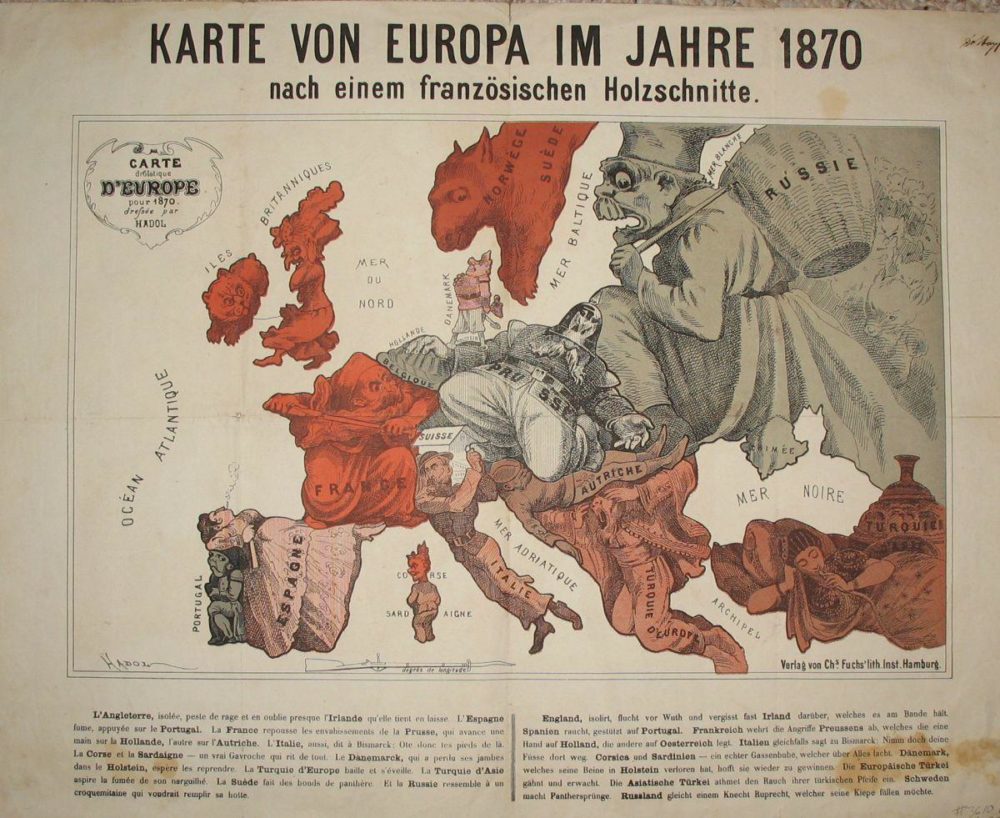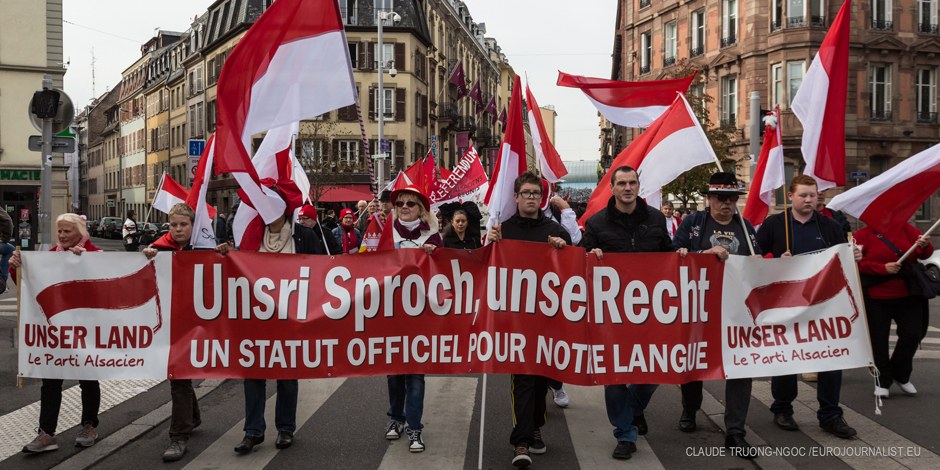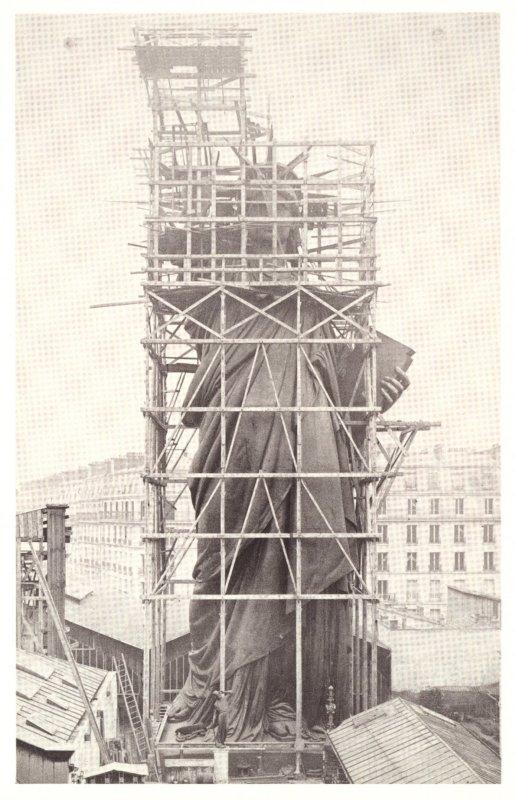
The Statue of Liberty, painting by Paul-Joseph-Victor Dargaud (1850-1921),
Among the quaint pistachio and avocado coloured houses on rue des Marchands in the Alsace town of Colmar sits the tiny Musée Bartholdi. On one side is a blue sandstone-trimmed shop cantilevered over the cobbled street, selling olive oils and Mediterranean soaps. On the other, a narrow pink Art Deco front, tarted up at the beginning of the last century, selling pastries, pies and vintage coffee pots. The visitor goes through a big carriage door into a substantial cobbled courtyard surrounded by a town house and its former stables. It’s where Frédéric Auguste Bartholdi was born in 1834. Bartholdi is the sculptor of Liberty Enlightening the World, better known as the Statue of Liberty – perhaps the most recognised statue on the planet.
Not a bad achievement for a local boy. The town is proud of him and his work which symbolises Franco-American friendship and the shared values passed from one revolution to the other.

Satirical map of the Franco-Prussian War, 1870, from a woodcut by Paul Hadol. Reprinted by Fuchs, Hamburg, 1914.
Bartholdi attended the Lycée Louis-le-Grand and studied at the Beaux Arts in Paris. During the Franco-Prussian War of 1870 he was on the French side, which lost. Alsace and Colmar passed into the new German Empire from which they were retrieved following another war and the Treaty of Versailles in 1919. This sent the Germans back to the old boundary of the Rhine river. The Voges region straddles one of those liminal areas contested for centuries: between Germany and France, along the border of the Holy Roman Empire, the chaffing edge of Celtica and Germania. Bartholdi’s roots are in a part of Europe with its own distinct identity, riven and fought over by great powers. The Black Forest on one side of the Rhine and the Voges Mountains on the other shelter the Alsatian language spoken by 600,000 people, a wine culture established since Roman times as well as a proud culinary tradition. Bartholdi had Alsatian and Italian heritage and acted as liaison officer to Garibaldi during the Franco-Prussian War. He knew all about code-shifting and multiculturalism.

Free Alsace, photographer unknown.
One still occasionally sees signs for Elsass Frei! pasted up on gable walls like the Red Hand of Ulster I remember flying in South Armagh, hard by the Irish border. Alsatian is a dialect of German, as are Swiss German, Swabian, Markgräflerisch and the dialect spoken in the Kaiserstühl. One tribe’s dialect can be another’s language: I never tire of telling my students that English is just a dialect that got lucky and found an island. Speakers of these dialects in southwest Germany, eastern France and the northwest corner of Switzerland mutually understand each other. The number of speakers of Alsatian is in decline and the French government, despite the European Charter on Regional and Minority Languages, is not particularly interested in fostering it.

Infographic of regional languages of France. Red Line language services.

Demonstrators for autonomy and federalism in Alsace, November 2015. Foto: Claude Truong-Ngoc
A study visit to Egypt in 1869 might have sparked Bartholdi’s interest in monumentalism, in thinking big. The victory of the Germans sharpened his regional identity and gave him a taste for republicanism. His first big sculpture was the Lion of Belfort, commissioned for a garrison town in southern Alsace, commemorating the Franco-Prussian War. It sits 11 meters high under the citadel, sculpted from the distinctive red sandstone of the Voges, a stone visible in many of the region’s cathedrals and on the trim of houses from Basel to Strasburg.

The Lion of Belfort, Auguste Bartholdi, 1875-1880.

Lady Liberty at the Universal Exhibition in Paris, 1878.
A visit to the United States in 1871 gave Bartholdi the idea of planting a statue on Beldoe Island in the approach to New York’s harbour. His friend, the parliamentarian Edouard Laboulaye, wanted to celebrate the centenary of American independence and give a boost to Franco-American relations. Between them they started pushing the project with fundraising and canny publicity. Bartholdi arranged for the head of the statue to be exhibited and photographed at the Paris Universal Exhibition in 1878, in front of the Grand Palais. The hand went to the Philadelphia Exhibition in 1876.
Parisians could see the statue towering over the Monceau plain in the workshop of Gaget Gauthier and Co., coopers and artistic plumbers in the 17th arrondissement. There were problems with the funding for the base on the American side of the project. Joseph Pulitzer, the press baron, stepped into the breach and raised funds through his newspaper The World.

Liberty in the workshop: Gaget Gauthier and Co. 25 rue de Chazelles, Paris 17.
Liberty was broken up into numbered pieces and put on the train from Paris to Rouen. These copper bits travelled on the ship l’Isère to New York with twelve workmen whose job was to reassemble her on arrival. The French government paid for the ship. Between 17 and 19 June 1885, Bartholdi’s enormous statue arrived in pieces in New York, greeted by a flotilla of about a hundred boats and ships. It was officially inaugurated on 28 October 1886, with Bartholdi present. There followed a week of parades, fireworks, fanfare and a love-affair with all things French. American President Grover Cleveland (1837-1908) gave a speech extolling the virtue of freedom.

Vintage postcard showing the Statue of Liberty.
Bartholdi has two other sculptures in North America – his fountain in Washington D.C. which he made for the Centennial Exhibition in Philadelphia in 1876 and Lafayette Arriving in America on the corner of Union Square in New York. A further monument by Bartholdi is dear to my heart as I remember picnicking underneath it when I was seventeen. At the edge of the Elisabethenanlage Park, facing Basel’s train station, is a sculpture of an angel and three figures, donated to the Swiss federation in 1895 in recognition of the help given to Strasbourg during the Franco-Prussian War by the Swiss – the Strassburger-Denkmal.

Stereoscopic picture of Bartholdi’s fountain in Washington D. C. on the grounds of the United States Capitol.

Bartholdi’s Strassburger Denkmal in Basel facing the city’s main train station.
Bartholdi died of tuberculosis in 1904. His Statue of Liberty lives on, as do his other monumental works, testifying to history and the complexity of trans-Atlantic allegiance. They haven’t yet succumbed to the fate of the monuments he saw in Egypt nor to the fate of Ozymandias’ statue in Shelley’s well-known poem:
Half sunk a shattered visage lies, whose frown,And wrinkled lip, and sneer of cold command,Tell that its sculptor well those passions readWhich yet survive, stamped on these lifeless things,…

Commemorative plaque at 25 rue de Chazelles in Paris, where the Statue of Liberty was assembled.

